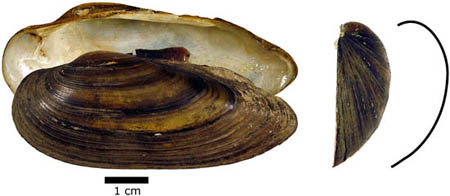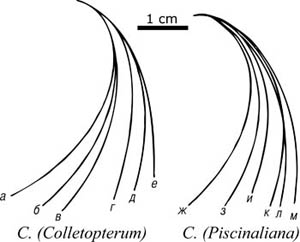Palearctic Freshwater Mussels
In the East: The Comparatory Method and Typology
Most modern treatments of the Palearctic freshwater mussels implicitly adhere to a Biological Species Concept (BSC) However, Ya.I. Starobogatov and his followers came up with a new method for recognizing species, the "Comparatory" (or "Comparatorial") Method (CM). The CM is described in detail (in English) by Shikov & Zatravkin (1991) and Korniushin (1998), and it has been applied in numerous recent papers.
The CM was born out of the search for diagnostic characters to distinguish freshwater mussel species, which exhibit notoriously confusing infra-specific variation. The practicioners of the CM believe they found the panacea for their problems in the contour of the frontal section of the shell. By tracing the profile of a freshwater mussel shell using a camera lucida, the resulting curve could be compared with the curves drawn from other specimens.

Unio pictorum and its frontal shell contour, as drawn from a digital photograph.
According to Shikov & Zatravkin (1991):
“The resultant picture is traced with drawing ink and thus, a stencil is obtained which may be used with the same drawing tube and at the same magnification without fail ... for comparison with other shell contours. ... If the shell contour of another mollusc does not coincide with the stencil contour, a new stencil should be drawn. Thus, molluscs are divided into groups corresponding to one or another stencil.” (p. 153)
And,
“The popularity of the comparative method is explained by its simplicity. Using it only practically, everybody can divide into groups more than 100 any shells within an hour. It permits us also to compare real shells with photograph or precise drawing of the type-specimen when present in literature.” (p. 156)
 The comparisons of frontal shell contours are strictly qualitative due to the difficulty of quantifying such a short segment of a logarithmic spiral. Moreover, advocates for the CM have taken their diagnostic character to its logical extreme: the observation that the frontal contour of the shell doesn't vary within species has become an assumption that it can't vary infra-specifically. By this method, freshwater musssel species are without an evolutionary basis, and the taxa recognized are typologically reduced to mere curves. For example, the illustration to the right was redrawn from Bogatov et al.'s (2005) revision of Russian Colletopterum spp. The comparisons of frontal shell contours are strictly qualitative due to the difficulty of quantifying such a short segment of a logarithmic spiral. Moreover, advocates for the CM have taken their diagnostic character to its logical extreme: the observation that the frontal contour of the shell doesn't vary within species has become an assumption that it can't vary infra-specifically. By this method, freshwater musssel species are without an evolutionary basis, and the taxa recognized are typologically reduced to mere curves. For example, the illustration to the right was redrawn from Bogatov et al.'s (2005) revision of Russian Colletopterum spp.
If one does not care to emphasize the philosophical or methodological differences between treating species as evolutionary entities and treating them as catagories of convenience (types), the contrast can be examined in a more practical context. The practioncers of the CM argue that the frontal shell contour does not vary: if two mussels have different curves, they belong to different species. Those that apply a Biological Species Concept allow that character (and others) to vary within species. All else being equal, a single Biological species can correspond to many Comparatory species.
Having outlined the theoretical and practical disparity between treating species as evolutionary entities and treating them as mere "types," it is straight-forward to compare diversity estimates of Palearctic freshwater mussels derived from these two schools of thought. Overall, the BSC recognizes 45 species in the region, whereas the CM increases this number to 156.
References
- Shikov, E.V. & M.N. Zatravkin. 1991. The comparative method of taxonomic study of Bivalvia used by Soviet malacologists. Malakologische Abhandlungen 15: 149-159.
- Korniushin, A.V. 1998. Review of the studies on freshwater mollusc systematics carried out by the Russian taxonomic school. Bivalvia I. Malacological Review, Supplement 7: 65-82.
|